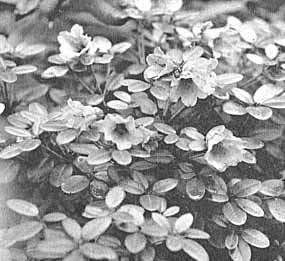QBARS - v10n4 R. williamsianum and Some of its Hybrids
R. williamsianum and Some of its Hybrids
By Cecil Smith, Aurora, Oregon

|
|
Fig. 35.
R. williamsianum
Cecil Smith photo |
In "The Species of Rhododendrons" williamsianum is classified in the subseries Souliei of the series Thomsonii. It is stated that the corolla is five lobed. I have observed plants from an expedition into China and a number from unknown sources and about half of the corollas had six lobes and there were more with seven lobes than with five lobes.
It appears to me to be closer to orbiculare in the fortunei series than to any other species, both in foliage and flower. Both are species from Szechwan.
Different plants of williamsianum vary in their growth habits, some plants are twice as wide as high and irregular in growth, some branches will grow out horizontally on the ground twice as fast as those near them and sometimes one or two will grow up rapidly outstripping its neighbors.
I have a plant from another source which is globular with its many branches remarkably even, but with leaves and flowers like the horizontal growing type. There is no evidence other than the shape of the bush that this is a cross with orbiculare.
Almost all plantings of williamsianum which I have seen have been in two-thirds shade to rather deep shade, and they all have had few flowers. They will take full sun here in the Willamette valley in Oregon with very little scorching of leaves even the first year after moving, which is more than can be said of many rhododendrons.
A serious disadvantage of bringing this species out into the open is that some protection from late spring frosts is lost. The young growths usually come in April and are very susceptible to frost injury. Any new shoots coming after the old ones are killed by frost are not apt to set bloom buds, so you can't win in either sun or shade in an exposed garden.
The new growth is one of the many attractions of williamsianum . The new leaves open to a bright rich chocolate in color and stay very attractive for several weeks before they turn to a bright green.
Cuttings will root readily as will those of most of its hybrids but it is a slow process to get any size to the root ball. Several very successful commercial propagators whose methods I have observed, attempt to get as large a root ball on cuttings of rhododendrons as quickly as possible. They just do not use pots as advocated by some writers on propagation.
To get good root system on williamsianum and some of its hybrids, particularly 'Bowbells', it is a common practice to graft them on ponticum stock.

|

|
|
Fig. 36. R. 'Bow Bells'
R. Henny photo |
Fig. 37. R. 'Thomwilliams'
R. Henny photo |
Williamsianum (Fig. 35) is the parent of many fine low to very low growing hybrids, and one of the best of these is 'Bowbells'. In ten years it will grow to five feet in a rather shady place and will not bloom as much as one might desire every year. In an open location it will bloom profusely and might not get over three feet high. in ten years. The hanging rosy pink bells are individually beautiful and when there is a good bloom set the whole plant is very effective. In my opinion a rhododendron with lax trusses must be covered with blooms to be effective. On the other hand, when the trusses are dome shaped or built up I like to see the most of them spaced so that they do not touch each other. Thinning often helps to bring this about. (Fig. 36)
'Jock', ( williamsianum X griersonianum ) is another fine plant with large rose-pink flowers. Plants six years old grown in afternoon shade are four feet high and do not bloom quite heavily enough. I have seen plants ten or twelve years old in full sun which are very compact and only two feet high. Their new growth is frosted most years but the second growth sets buds, and the plants are a mass of bloom. The foliage never seems to scorch.
'Moonstone', a cross with campylocarpum , has fine cream colored campanulate corollas. Other crosses which I have seen that are good are: 'Arthur J. Ivens', 'Temple Belle', and 'Thomwilliams'. (Fig. 37)
Williamsianum is a hardier plant than haematodes , another much used dwarf species and puts more hardiness into its progeny. 'Jock', ( williamsianum X griersonianum ) for instance, will stand a winter with no bud or leaf injury, which will severely injure 'May Day', ( haematodes X griersonianum ).

|

|
|
Fig. 38. R. 'Treasure'
R. Henny photo |
Fig. 39. R. 'Hummingbird'
R. Henny photo |
R. 'Thomwilliams' ( williamsianum X thomsonii ) (Fig. 37) with fleshy dark pink campanulate bloom. R. 'Treasure' ( forrestii var. repens X williamsianum ) (Fig. 38) a very slow growing dwarf with single flowers of crimson, eventually forms a mat.
To this date, williamsianum is the parent of the best group of dwarf hybrids that we have for the Northwest climate.
